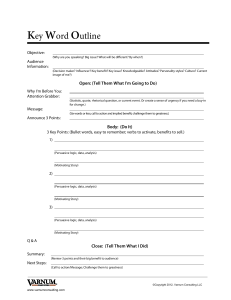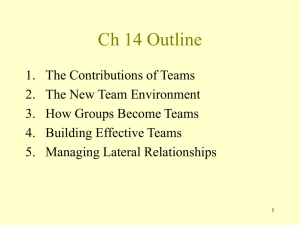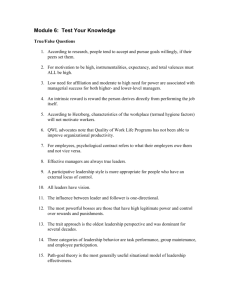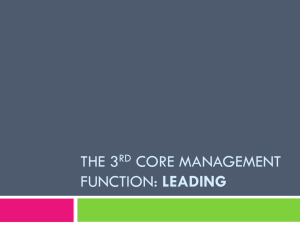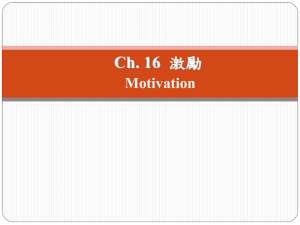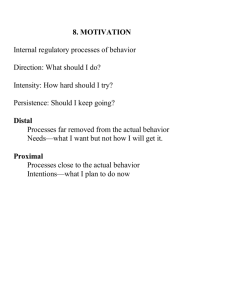Lecture notes on Motivation
advertisement
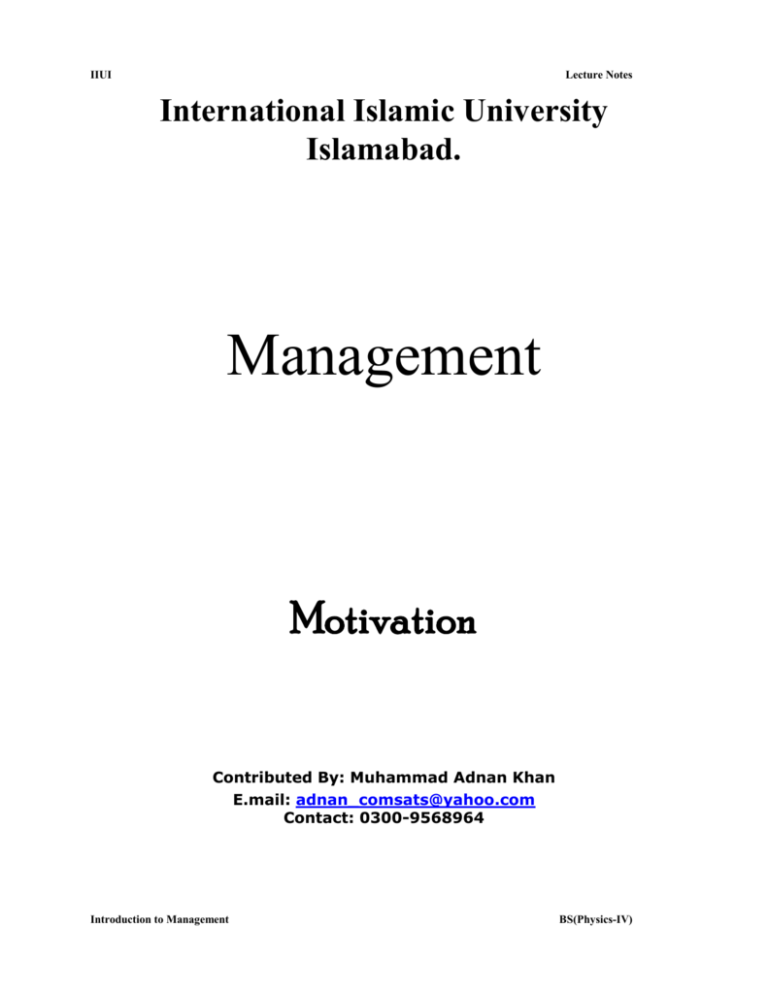
IIUI Lecture Notes International Islamic University Islamabad. Management Motivation Contributed By: Muhammad Adnan Khan E.mail: adnan_comsats@yahoo.com Contact: 0300-9568964 Introduction to Management BS(Physics-IV) IIUI Lecture Notes Lecture Outline: Introduction What Is Motivation? Early Theories of Motivation Maslow’s Hierarchy of Needs Theory McGregor’s Theory X and Theory Y Herzberg’s Motivation-Hygiene Theory Contemporary Theories of Motivation Three-Needs Theory Goal-Setting Theory Reinforcement Theory Designing Motivating Jobs Job Enlargement Job Enrichment Job Characteristics Model Equity Theory Expectancy Theory Integrating Contemporary Theories of Motivation Current Issues in Motivation Motivating a Diverse Workforce Flexible Working Schedules Cultural Differences in Motivation Pay-for-Performance Open-Book Management Motivating the “New Workforce” Motivating Professionals Motivating Contingent Workers Motivating Low-Skilled, Minimum-Wage Employees From Theory to Practice: Suggestions for Motivating Employees Introduction to Management BS(Physics-IV) IIUI Lecture Notes 1. INTRODUCTION. Managers need to know about motivational concepts and practices in order to encourage their employees to put forth maximum effort. This lecture covers the concepts of motivation. 2. WHAT IS MOTIVATION? We define motivation as the willingness to exert high levels of effort to reach organizational goals, conditioned by the effort’s ability to satisfy some individual need. A. Effort is a measure of intensity or drive. High levels of effort are unlikely to lead to favorable job performance unless the effort is channeled in a direction that benefits the organization. B. A need is an internal state that makes certain outcomes appear attractive. An unsatisfied need creates tension that stimulates drives within an individual. These drives generate a search behavior to find particular goals that, if attained, will satisfy the need and reduce the tension. 3. EARLY THEORIES OF MOTIVATION. Three early theories of motivation provide the best-known explanations for employee motivation, even though they are somewhat questionable in terms of validity. A. Maslow’s hierarchy of needs theory was developed by Abraham Maslow. It states that there is a hierarchy of five human needs. 1. As each need is substantially satisfied, the next need becomes dominant. 2. These five needs are physiological (basic food, drink, water, shelter, and sexual needs), safety (security and protection from physical and emotional harm), social (affection, belongingness, acceptance, and friendship), esteem (internal factors such as self-respect, autonomy, and achievement, and external factors such as status, recognition, and attention), and self-actualization (a person’s drive to become what he or she is capable of becoming). 3. Maslow also separated the needs into lower-level needs (includes the physiological and safety needs) and higher-level needs (includes social, esteem, and self-actualization). 4. Although Maslow’s theory is widely recognized, research generally has not validated the theory. B. McGregor’s Theory X and Theory Y were developed by Douglas McGregor and describe two distinct views of human nature. 1. Theory X was the assumption that employees dislike work, are lazy, seek to avoid responsibility, and must be coerced to perform. 2. Theory Y was the assumption that employees are creative, seek responsibility, and can exercise self-direction. 3. Theory X assumed that lower-order needs (Maslow’s) dominated individuals, and Theory Y assumed that higher-order needs dominated. C. Motivation-hygiene theory is the theory developed by Frederick Herzberg that suggests that intrinsic factors are related to job satisfaction and motivation, and extrinsic factors are associated with job dissatisfaction. Introduction to Management BS(Physics-IV) IIUI Lecture Notes 1. The basis of Herzberg’s theory is that he believed that the opposite of satisfaction was not dissatisfaction. Removing dissatisfying characteristics from a job would not necessarily make the job satisfying. 2. Hygiene factors are factors that eliminated dissatisfaction. They included things such as supervision, company policy, salary, working conditions, security, and so forth—extrinsic factors associated with job context, or those things surrounding a job. Motivators were factors that increased job satisfaction and hence motivation. They included things such as achievement, recognition, responsibility, advancement, and so forth—intrinsic factors associated with job content, or those things within the job itself. Herzberg’s theory has been criticized for the statistical procedures and methodology used in his study. Even considering the criticisms, Herzberg’s theory has had a strong influence on how we currently design jobs. 3. 4. 5. 4. CONTEMPORARY THEORIES OF MOTIVATION. The theories and approaches we’re going to look at represent the state-of-the-art explanations of employee motivation. These contemporary theories have a reasonably strong degree of valid supporting documentation. A. The three-needs theory was developed by David McClelland and cites the needs for achievement, power, and affiliation as major motives in work. 1. The need for achievement (nAch) is defined as the drive to excel, to achieve in relation to a set of standards, to strive to succeed. a. McClelland found that high achievers differentiate themselves from others by their desire to do things better. b. High achievers like moderately challenging goals. c. They avoid what they perceive to be very easy or very difficult tasks. 2. The need for power (nPow) is defined as the need to make others behave in a way that they would not have behaved otherwise. 3. The need for affiliation (nAff) is defined as the desire for friendly and close interpersonal relationships. 4. A person’s levels of these three needs are typically measured by reacting to a set of pictures included in the Thematic Apperception Test or TAT. 5. What predictions about motivation can we make from three-needs theory? a. Individuals with a high need to achieve prefer and are strongly motivated in job situations with personal responsibility, feedback, and an intermediate degree of risk. b. A high need to achieve does not necessarily lead to being a good manager, especially in large organizations. c. A low need for affiliation and a high need for power are closely related to managerial success. d. Employees can be trained to spur their achievement need. Introduction to Management BS(Physics-IV) IIUI Lecture Notes B. Goal-setting theory says that specific goals increase performance, and difficult goals, when accepted, result in higher performance than easy goals. What do we know about goals as motivators? 1. Intention to work toward a goal is a major source of job motivation. Specific and challenging goals are superior motivating forces. Specific hard goals produce a higher level of output than do generalized goals. 2. Is there a contradiction between achievement motivation and goal setting? No, and here’s why. a. Goal-setting theory deals with people in general; achievement theory is based only on people who have a high need for achievement. Difficult goals are still recommended for the majority of employees. b. The conclusions of goal-setting theory apply to those who accept and are committed to the goals. Difficult goals will lead to higher performance only if they are accepted. 3. Will employees try harder if they participate in the setting of goals? a. b. 4. We can’t say that participation is always desirable. However, participation is probably preferable to assigning goals when the manager expects resistance. Will people do better when they get feedback on how well they’re progressing toward their goals? a. b. 5. 6. Feedback acts to guide behavior. Self-generated feedback has been shown to be a more powerful motivator than externally generated feedback. What contingencies exist in goal-setting theory? There are four contingencies we need to know about. a. Feedback influences the goal-performance relationship. b. Goal commitment is another contingency. Commitment is most likely to occur when goals are made public, when the individual has an internal locus of control, and when the goals are self-set rather than assigned. c. Self-efficacy is another contingency and refers to an individual’s belief that he or she is capable of performing a task. The higher your selfefficacy, the more confidence you have in your ability to succeed in a task. d. The last contingency that affects goal setting is national culture. Our conclusion about motivation from goal-setting theory is that intentions, as defined by hard and specific goals, are a powerful motivating force. a. In the proper conditions, they can lead to higher performance. b. However, there’s no evidence that such goals are associated with increased job satisfaction. Introduction to Management BS(Physics-IV) IIUI Lecture Notes C. Reinforcement theory is counter to goal-setting theory. It proposes that behavior is a function of its consequences. 1. Reinforcement theory argues that behavior is externally caused. 2. What controls behavior are reinforcers, which are consequences immediately following a response that increase the probability that the behavior will be repeated. 3. Reinforcement theory ignores factors such as goals, expectations, and needs. 4. It focuses solely on what happens when a person takes some action. 5. How can the concept of reinforcement be used to explain motivation? a. People will most likely engage in a desired behavior if they are rewarded for doing so. b. These rewards are most effective if they immediately follow a desired response. c. Behavior that isn’t rewarded or is punished is less likely to be repeated. 6. Managers can influence employees’ behavior by reinforcing the work behaviors they desire. D. Designing Motivating Jobs. Job design can also be used to influence employee motivation. Job design is the way tasks are combined to form complete jobs. Managers should design jobs to reflect the demands of the changing environment as well as the organization’s technology, skills, and abilities and preferences of its employees. 1. One of the earliest efforts at overcoming the drawbacks of job specialization was through increasing job scope, the number of different tasks required in a job and the frequency with which those tasks are repeated. a. This type of job design is called job enlargement—the horizontal expansion of a job or an increase in job scope. b. Job design programs that focused solely on task enlargement haven’t been very successful. c. When knowledge enlargement activities were implemented, however, workers were more satisfied and made fewer errors. 2. Another approach to designing motivating jobs is job enrichment, which is the vertical expansion of a job by adding planning and evaluating responsibilities. a. In job enrichment, job depth, the degree of control employees have over their work, is increased. b. Research evidence on job enrichment activities has been inconclusive about its benefits. 3. The job characteristics model (JCM) provides a framework for analyzing and designing jobs. It identifies five primary job characteristics, their interrelationships, and their impact on employee productivity, motivation, and satisfaction. These five job dimensions include the following. a. Skill variety is the degree to which a job requires a variety of activities so that an employee can use a number of different skills and talents. b. Task identity is the degree to which a job requires completion of a whole and identifiable piece of work. c. Task significance is the degree to which a job has a substantial impact on the lives or work of other people. Introduction to Management BS(Physics-IV) IIUI Lecture Notes d. e. f. g. h. i. Autonomy is the degree to which a job provides substantial freedom, independence, and discretion to the individual in scheduling the work and determining the procedures to be used in carrying it out. Feedback is the degree to which carrying out the work activities required by a job results in the individual’s obtaining direct and clear information about the effectiveness of his or her performance. Skill variety, task identity, and task significance combine to create meaningful work. Autonomy leads to an increased sense of responsibility for outcomes of the work. Feedback leads to knowledge of the actual results of the work activities. The JCM suggests that intrinsic (internal) rewards are gained when an employee learns (knowledge of results through feedback) that he or she personally (experienced responsibility through autonomy of work) has performed well on a task that he or she cares about (experienced meaningfulness of work through skill variety, task identify, and/or task significance). The more that these three conditions characterize a job, the greater the employee’s work motivation, performance, and satisfaction and the lower his or her absenteeism and likelihood of resigning. The JCM also provides specific guidelines to managers for job design. E. Equity theory, developed by J. Stacey Adams, says that an employee perceives what he or she got from a job situation (outcomes) in relation to what he or she put into it (inputs) and then compares the inputs-outcomes ratio with the inputs-outcomes ratios of relevant others and finally corrects any inequity. 1. The referents are the persons, systems, or selves against which individuals compare themselves to assess equity. 2. Equity theory recognizes that individuals are concerned with their absolute rewards as well as the relationship of those rewards to what others receive. 3. What will employees do when they perceive an inequity? a. Distort either their own or others’ inputs or outcomes. b. Behave in some way to induce others to change their inputs or outcomes. c. Behave in some way to change their own inputs or outcomes. d. Choose a different comparison person. e. Quit their job. F. Expectancy theory is the theory that an individual tends to act in a certain way based on the expectation that the act will be followed by a given outcome and on the attractiveness of that outcome to the individual. Three relationships are important to this theory. 1. Effort-performance linkage (expectancy) is the probability perceived by the individual that exerting a given amount of effort will lead to a certain level of performance. 2. Performance-reward linkage (instrumentality) is the degree to which an individual believes that performing at a particular level is instrumental in, or will lead to, the attainment of a desired outcome. 3. Attractiveness of the reward (valence) is the importance that the individual places on the potential outcome or reward that can be achieved on the job. 4. There are four features inherent in the theory. Introduction to Management BS(Physics-IV) IIUI Lecture Notes a. b. c. 5. G. Integrating Contemporary Theories of Motivation. 1. 2. 3. 5. What perceived outcomes does the job offer the employee? How attractive do employees consider these outcomes to be? What kind of behavior must the employee exhibit to achieve these outcomes? d. How does the employee view his or her chance of doing what is asked? The key to understanding expectancy theory is understanding an individual’s goal and the linkage between effort and performance, between performance and rewards, and between rewards and individual goal satisfaction. The basic foundation is the simplified expectancy model. The model also considers the achievement-need, reinforcement, equity, and JCM theories. Rewards also play an important role in the model. CURRENT ISSUES IN MOTIVATION. Understanding and predicting employee motivation continues to be one of the most popular areas in management research. Several significant workplace issues are important to look at in understanding motivation. A. Motivating a Diverse Workforce. One of these current issues is motivating a diverse workforce. To maximize motivation among today’s diverse workforce, managers need to think in terms of flexibility. Many of the so-called family-friendly programs and flexible working schedules that organizations have developed are a response to the varied needs of a diverse workforce. B. Flexible Working Schedules. 1. A compressed workweek is a workweek comprised of four 10-hour days. 2. Flexible work hours (flextime) describes a scheduling system in which employees are required to work a number of hours a week, but are free, within limits, to vary the hours of work. 3. Job sharing is the practice of having two or more people split a 40-hour-a-week job. 4. Telecommuting allows employees to do their work at home by linking their computers to the office. a. The advantages of telecommuting are the decrease in the time and stress of commuting and the increase in flexibility in coping with family demands. b. The drawbacks revolve around the lack of social contact, the reward system used, and the separation of organization work and home work. 5. Cultural differences also play a role in motivating a diverse workforce. Managers need to be aware of cultural differences in developing appropriate motivation programs. Introduction to Management BS(Physics-IV) IIUI 6. Lecture Notes C. Pay-for-performance programs are compensation plans that pay employees on the basis of some performance measure. 1. Performance-based compensation is probably most compatible with expectancy theory. 2. The increasing popularity of pay-for-performance programs can be explained in terms of both motivation and cost control. 3. Do pay-for-performance programs work? Studies seem to indicate that they do. C. Open-book management is a motivational approach in which an organization’s financial statements (the “books”) are opened to and shared with all employees. 1. The goal of open-book management is to get employees to think like an owner by seeing the impact their decisions and actions have on financial results. 2. To be effective, employees have to be taught the fundamentals of financial statement analysis and what the numbers show. D. Motivating the “New Workforce.” Another current motivation issue revolves around motivating the “new workforce.” These special groups present unique motivational challenges to managers. 1. Motivating professionals is one of these special challenges. a. Professionals are different from nonprofessionals and have different needs. b. Money and promotions are typically low on the motivation priority list for professionals. Job challenge is usually ranked high as is support and the feeling that they’re working on something important. 2. Contingent workers are another of the special groups that managers may have to motivate. a. Contingent workers don’t have the security or stability that permanent employees do. b. Some things that managers might use include the opportunity for permanent status, opportunity for training, and equitable treatment. 3. Motivating low-skilled, minimum-wage workers is one of the toughest motivation challenges a manager might face. a. Although money is important as a motivator, it’s not the only reward that people seek and that managers can use. b. Also, job design and expectancy theories can provide some answers to motivating this group. FROM THEORY TO PRACTICE: SUGGESTIONS FOR MOTIVATING EMPLOYEES Several suggestions for motivating employees are given and are based on what is currently known about motivation. Introduction to Management BS(Physics-IV) IIUI Lecture Notes A. Recognize individual differences in terms of needs, attitudes, personality, and other important individual factors. B. Match people to jobs by identifying what needs are important to individuals and trying to provide jobs that allow them to fulfill those needs. C. Use goals because the literature on goal setting suggests that managers should ensure that employees have hard, specific goals and feedback on how well they’re doing in pursuit of those goals. D. Ensure that goals are perceived as attainable. Employees who see goals as unattainable will reduce their levels of effort. E. Individualize rewards. Because employees have different needs, what is a reward and reinforcer to one may not work for another. F. Link rewards to performance by making rewards contingent on desired levels of performance. G. Check the system for equity. Employees should perceive that the rewards or outcomes are equal to the inputs given. H. Don’t ignore money. The allocation of performance-based increases, piecework bonuses, and other pay incentives is important in determining employee motivation. Some Important Short Questions. 1. What is motivation, and how is Maslow’s hierarchy of needs theory a theory of motivation? Motivation is the willingness to exert high levels of effort to reach organizational goals as conditioned by that effort’s ability to satisfy some individual need. Maslow’s theory proposed that, although no need was ever fully satisfied, a substantially satisfied need would no longer motivate an individual. 2. What are McGregor’s Theory X and Theory Y assumptions? McGregor’s Theory X presented an essentially negative view of people that assumed they have little ambition, dislike work, want to avoid responsibility, and need to be closely directed. Theory Y offered a positive view that people can exercise self-direction, accept responsibility, and consider work to be as natural as rest or play. Introduction to Management BS(Physics-IV) IIUI Lecture Notes 3. Describe Herzberg’s motivation-hygiene theory. 4. What are the three needs McClelland proposed that are present in work situations? 5. Describe how goal-setting theory explains employee motivation. 6. What does reinforcement theory tell us about employee motivation? 7. Define job enlargement and job enrichment. 8. Describe the job characteristics model as a way to design motivating jobs. 9. What are the motivation implications of equity theory? 10. Describe the three key linkages in expectancy theory. 11. What role does perception play in expectancy theory? 12. How might the contemporary motivation theories be integrated to explain employee motivation? Herzberg’s motivation-hygiene theory said that factors leading to job satisfaction were separate and distinct from those that led to job dissatisfaction. Managers who sought to eliminate job dissatisfaction could bring about workplace harmony, but not necessarily motivation. David McClelland proposed three needs: the need for achievement (nAch), the need for power (nPow), and the need for affiliation (nAff). Goal-setting theory explains employee motivation in terms of specific goals that increase performance. Also, difficult goals, when accepted, result in higher performance than do easier goals. Reinforcement theory argues that behavior is externally caused by reinforcers, consequences that increase the probability a behavior will be repeated. Job enlargement is the horizontal expansion of a job through increasing job scope, the number of different tasks required and their frequency. Job enrichment is the expansion of a job by additional planning and evaluating responsibilities. The job characteristics model identifies five primary job characteristics (skill variety, task identity, task significance, autonomy, and feedback), their interrelationships, and their impact on employee productivity, motivation, and satisfaction. Equity theory proposes that employees perceive what they get from a job situation (outcomes) in relation to what they put into it (inputs) and then compare their inputs-outcomes ratio with those of relevant others (referents). If employees perceive inequity, they will act to correct the situation. The three key linkages in expectancy theory are expectancy or effort-performance, instrumentality or performance-reward, and valence or attractiveness of reward. Expectancy theory is concerned with perceptions; reality is irrelevant. An individual’s own perceptions of performance, reward, and goal satisfaction outcomes determine his or her level of effort, not the objective outcomes themselves. Because contemporary theories of motivation put forth complementary ideas, each can be used to explain motivation, or the effort an individual is willing to expend on meeting the organization’s goals. See Exhibit 16.11 on p. 441. 13. What are some options for motivating a diverse workforce? In motivating a diverse workforce, managers can use flexibility, family-friendly programs, a compressed workweek, flextime, job sharing, and telecommuting. Introduction to Management BS(Physics-IV) IIUI Lecture Notes 14. How is performance-based compensation compatible with expectancy theory? 15. What are some special challenges in motivating (a) professional workers, (b) contingent workers, and (c) low-skilled, minimum-wage workers? Performance-based compensation is compatible with expectancy theory in that individuals should perceive a strong relationship between their performance and the rewards they receive if motivation is to be maximized. Special challenges in motivating professionals include their long-term commitment to their field of expertise, with greater loyalty to their profession than to their employer. Money and promotions are typically low on professionals’ priority list. Contingent workers lack the security that permanent employees have and do not identify with or display much commitment to the organization. Temporary workers also typically lack benefits such as health care and pensions. Low-skilled minimum-wage workers typically have limited education and skills; offering higher pay is usually not an option. 16. List some practical suggestions for motivating employees. Practical suggestions for motivating employees include: recognize individual differences, match people to jobs, use goals, ensure that goals are perceived as attainable, individualize rewards, link rewards to performance, check the system for equity, and don’t ignore money. Answers to Thinking About Management Issues 1. Most of us have to work for a living, and a job is a central part of our lives. So why do managers have to worry so much about employee motivation issues? Even though most of us have to work and therefore need a job, managers still have to worry about employee motivation because employees aren’t always willing to put forth the effort to do their job well. Also, even for employees who are willing to put forth effort, we want to make sure that they continue to perform at the levels we need to reach organizational goals. 2. If you had to develop an incentive system for a small manufacturing company that makes flour and corn tortillas, which elements from which motivation approaches or theories would you use? Why? Would your choice be the same if it were a software design firm? Explain. students will probably design different systems depending on which motivation approach they pick. Be sure that they take into account motivating different types (that is, professional versus nonprofessional) of employees as they develop this system. Also, be sure that they explain their rationale for using the one(s) that they did. 4. Could managers use any of the motivation theories or approaches to encourage and support workforce diversity efforts? Explain. To maximize motivation in today’s diverse workforce, managers need to be flexible. Employees have different personal needs and goals that they’re trying to satisfy through their job. Offering various types of rewards to meet these diverse needs can be highly motivating for employees. Managers could use goal-setting theory to encourage and support diversity efforts by establishing goals for increasing or embracing diversity. Managers could use JCM to design jobs that emphasized the skills and abilities of diverse employees and that recognized the unique needs of diverse employees such as compressed workweek, flexible work hours, job sharing, and so forth. Introduction to Management BS(Physics-IV) IIUI 5. Lecture Notes Many job design experts who have studied the changing nature of work say that people do their best work when they’re motivated by a sense of purpose rather than by the pursuit of money. Do you agree? Explain your answer. Again, student responses to this question will vary. Some other possible criteria that you might suggest include the chance to make friends, promotion possibilities, the chance to travel, not having to relocate, and reimbursement for further education, among others. The Managing in an E-Business World box addressed a similar concept. Introduction to Management BS(Physics-IV)
